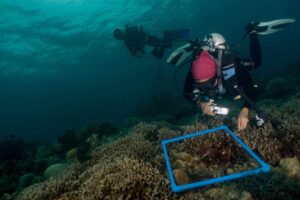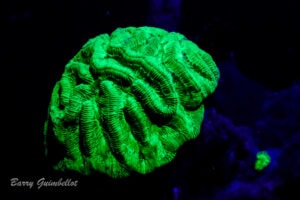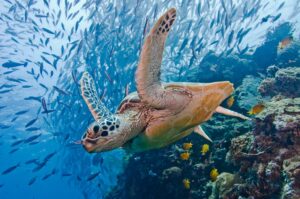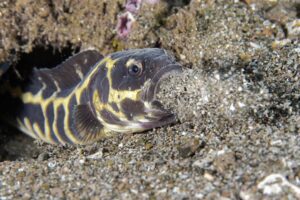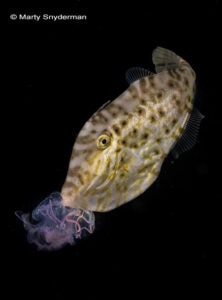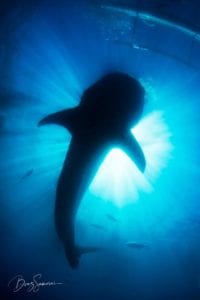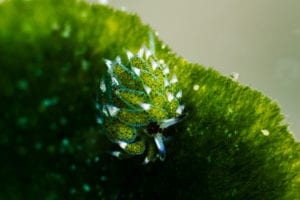[vc_row bg_style=”stretch”][vc_column width=”1/2″ css=”.vc_custom_1510908424132{margin-bottom: 0px !important;padding-top: 0px !important;padding-right: 20px !important;padding-bottom: 0px !important;padding-left: 20px !important;background-color: #ffffff !important;border-radius: 5px !important;}”][vc_column_text css=”.vc_custom_1585930856695{padding-bottom: 25px !important;}”]By Marty Snyderman
From a distance they are sometimes mistaken for moray eels. But unlike morays, they are not fishes, and they often boldly swim up to divers. And once they are upon us, they often give what feels like a rather intense inspection before they move along.
Although some are drably colored, others are elegant and handsome. I would even say striking, but that is the one thing you hope that they are not. That’s because they are highly venomous. They are the marine reptiles we call sea snakes and sea kraits, and they are always a thrill to see.
Upon first glance sea snakes and sea kraits certainly look a lot alike to most lay divers, and many sport divers have never heard the common name sea krait. However, specialists know sea snakes and sea kraits to be significantly groups of animals.
Sea snakes are believed to have evolved from a group of highly venomous terrestrial snakes that inhabited Australia just over 300 million years ago. These sea serpents live their entire lives in the sea, and are the only reptiles that give birth in the sea.
It is likely that sea kraits first appeared some 5 to 10 million years earlier than sea snakes. They, too, are the descendants of land dwelling venomous snakes. But unlike sea snakes, sea kraits routinely leave the aquatic environment going onto land to mate, lay eggs, digest food, and rest. The bodies of all sea kraits exhibit distinct bands.
Like sea snakes, sea kraits are air breathers, and due to their need to breathe air they spend the majority of their lives in the top 100 feet of water. However, they routinely spend between 30 minutes and two hours at a time underwater.
Featured here and commonly encountered in the Philippines and throughout the Coral Triangle, the yellow-lipped sea krait (aka yellowhead sea krait and banded sea krait – Laticauda colubrina) is usually found in shallow, marine areas including mangroves and coral reef communities. When on land, they tend to be found on sandy beaches, coral islands, and in low hanging trees (although this is rather rare).
As is the case with other sea kraits, the yellow-lipped sea krait has a cylindrical body with a tail that is highly compressed from side-to-side. They have anywhere from 20 to 65 black bands on a blue to blue-gray body. Relatively small, adult males attain a maximum length of only 2.5 feet. Females grow considerably larger, attaining a maximum length of just over 4 feet. The upper lip and snout show a yellowish hue.
The venom of sea kraits affects both nerves and muscles, and the venom is roughly 10 times as potent as that of a highly poisonous rattlesnake. The good news is that sea kraits tend to be extremely docile. Don’t grab or otherwise impede them, which seems like a silly thing to say, and while they might investigate you, they do not pose a threat.
Yellow-lipped sea kraits search in cracks and crevices of reefs for resting fishes and other prey. They also hunt by floating at the surface where they wait for curious fishes to seek shelter under their bodies, hiding places that can prove fatal.
In turn, yellow-lipped sea kraits are preyed upon by a variety of relatively large fishes such as some groupers, some sharks, and the birds known as sea eagles (aka ospreys).
When hunting, yellow-lipped sea kraits rely heavily on their keen senses of touch and smell. Even in the water they can use their bifurcated tongues to smell their surroundings. The tongue collects particles in the water and brings them into the mouth where they are introduced to the Jacobson’s organ, a specialized organ of smell located in the roof of the mouth that assists in the detection and identification of prey.
You have a chance of seeing a sea krait while diving at Atlantis Dumaguete or Atlantis Puerto Galera![/vc_column_text][/vc_column][vc_column width=”1/2″][vcex_image_grid columns=”3″ columns_gap=”5″ title=”no” image_ids=”9651,9650,9647,9649,9648″][/vc_column][/vc_row]


